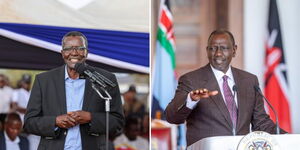In a poignant conclusion to a historic mountaineering endeavour, the family and friends of Joshua Cheruiyot Kirui face the daunting prospect of repatriating his body from the treacherous heights of Mount Everest, a mission that could demand upwards of Ksh13 million ($100,000).
Kirui, aged 40, set out on a daring mission to become the first African to conquer Everest without supplementary oxygen, accompanied by his Nepali guide Nawang Sherpa, 44. However, tragedy struck as Kirui's body was discovered just below the summit, leaving his fate entwined with the unforgiving slopes of the world's tallest peak.
Nevertheless, the quest to break the record ended tragically when rescuers discovered Kirui's death within meters from Everest's summit, according to base camp officials. The whereabouts of Nawang Sherpa, Kirui's constant companion on their treacherous trek, are unknown, veiled in the mystery of the mountain's death zone.
Reports indicate that Kirui, exhibiting abnormal behaviour, had eschewed the use of bottled oxygen and refused to descend, ultimately succumbing to the harsh conditions.
The news sent shockwaves through Kirui's circle of companions, including close hiking friend Kipkemoi Limo, who expressed disbelief at Kirui's untimely demise.
Limo, reflecting on Kirui's meticulous preparations and unparalleled dedication to the challenge, recounted the extensive training and financial investment Kirui had committed to his Everest bid.
With a budget exceeding Ksh7 million (£47,000), Kirui left no stone unturned in his quest for Everest's summit, drawing from his experience scaling other formidable peaks like Nepal's Mount Manaslu.
Yet, amidst the grief and uncertainty, a crucial question looms over Kirui's final resting place. Did he harbour a desire to be interred on Everest's icy slopes, or did his heart long for the tranquil soil of his homeland in Kenya? The answer remains elusive, intensifying the anguish for Kirui's loved ones as they navigate the complexities of repatriating his body.
What it will take?
Retrieving a body from Mount Everest is a perilous and expensive operation. It requires a team of skilled rescuers, or Sherpas, who can excavate the frozen corpses and carry the additional weight down the treacherous mountain.
The expenses for such an operation often exceed $100,000 due to the high costs and extreme risks involved. Consequently, only a few bodies have ever been successfully brought down from Everest and other peaks above 7000 and 8000 meters.
Climbing Everest, the world's highest peak, is considered extremely difficult and risky, even for experienced climbers.
Nearly 300 mountaineers have died on Everest since the first ascent attempt, and it is estimated that two-thirds of their bodies are still buried in the snow and ice. Climbers and Sherpas lie tucked into crevasses, buried under avalanche snow, and exposed on catchment basin slopes—their limbs sun-bleached and distorted. Most are concealed from view, but some have become familiar fixtures on the route to Everest’s summit.
The act of retrieving a body from Everest is extraordinarily challenging. Ang Tshering Sherpa, president of the Nepal Mountaineering Association, explained to the BBC that even picking up a candy wrapper high up on the mountain requires significant effort, as it’s frozen and must be dug out. A dead body that normally weighs 80 kilograms might weigh 150 kilograms when frozen and dug out with the surrounding ice attached.
To remove a body, teams typically use rigging such as a sled or a piece of fabric. They tie ropes onto this makeshift rig and then perform a controlled slip of the body down to the next camp. Cremation on the mountain is not feasible due to the lack of wood or stove fuel, so bodies need to be brought low enough for helicopters to pick them up, adding another hurdle to the retrieval process.
Between Everest's base camp and the summit are four camps, each presenting its own challenges. Helicopters, due to the thinness of the air, usually do not land above Camp 2, which is situated at 21,000 feet.
Climbing Everest, often dubbed the 'roof of the world', exacts a toll not only on the physical endurance of climbers but also on their financial resources and, tragically, their very lives.
As Kirui's loved ones grapple with the arduous task of repatriation, they confront the grim reality of Everest's unforgiving embrace, where the pursuit of glory can at times end in pain.












